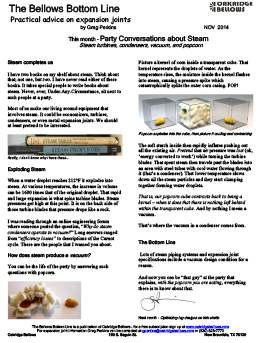Party Conversations about Steam

Steam completes us
I have two books on my shelf about steam. Think about that; not one, but two. I have never read either of these books. It takes special people to write books about steam. Never, ever, Under.Any.Circumstance, sit next to such people at a party.
Most of us make our living around equipment that involves steam. It could be economizers, turbines, condensers, or even metal expansion joints. We should at least pretend to be interested.
Really, I don’t know why I have these…
Exploding Steam
When a water droplet reaches 212°F it explodes into steam. At various temperatures, the increase in volume can be 1600 times that of the original droplet. That rapid and large expansion is what spins turbine blades. Steam pressures get high at this point. It is on the back side of those turbine blades that pressure drops like a rock. I was reading through an online engineering forum where someone posted the question, “Why do steam condensers operate in vacuum?” Long answers ranged from “efficiency losses” to descriptions of the Carnot cycle. These are the people that I warned you about.
How does steam produce a vacuum?
You can be the life of the party by answering such questions with popcorn. Picture a kernel of corn inside a transparent cube. That kernel represents the droplets of water. As the temperature rises, the moisture inside the kernel flashes into steam, causing a pressure spike which catastrophically splits the outer corn casing. POP!
Popcorn explodes into the cube, then picture it cooling and contracting The soft starch inside then rapidly inflates pushing out all the existing air. Pretend that air pressure was lost (ok, ‘energy converted to work’) while turning the turbine blades. That spent steam then travels past the blades into an area with steel tubes with cool water flowing through it (that’s a condenser). That lower temperature slows down all the steam particles and they start clumping
together forming water droplets.
That is, our popcorn cube contracts back to being a kernel – when it does that there is nothing left behind within the transparent cube. And by nothing I mean a vacuum.
That’s where the vacuum in a condenser comes from.
The Bottom Line
Lots of steam piping systems and expansion joint specifications include a vacuum design condition for a reason.
And now you can be “that guy” at the party that explains, with the popcorn you are eating, everything there is to know about that.


